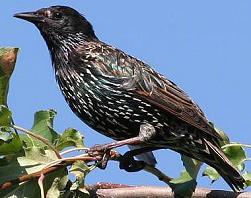European Starling

Identification and Pictures
(Sturnus vulgaris)
Starlings are short tailed black birds,
with long pointed bills, triangular wings, and black eyes;
about 7
1/2 to 8 1/2 inches. They are shaped a little like
a meadowlark.
Their legs are pinkish-red. They have a purple or green
iridescence, and a yellow
bill in breeding plumage. Later they are heavily
speckled in brilliant white spots, and have a dark, bill.
Male, and female are similar, and young starlings are dusky gray-brown.
They have a direct swift flight. Similar species are Brewers
blackbird, and cowbirds.
Photos by Keith Lee.
The camera I use is the Canon
EOS 40D. Visit All-birds store
Range and Habitat
 They
were introduced to America in the 1890, and
are now one of our most numerous song birds. They
can be found in cities, parks, open country, and
fields. They form into huge, loud flocks,
sometimes covering lawns, or fields as they forage for
food. Flocks will often be mixed with other birds
such as Red-winged
blackbirds, cowbirds, and
others. Large groups will perch on power lines.
The huge flocks are incredible to watch as they form
amazing flowing formations. They
were introduced to America in the 1890, and
are now one of our most numerous song birds. They
can be found in cities, parks, open country, and
fields. They form into huge, loud flocks,
sometimes covering lawns, or fields as they forage for
food. Flocks will often be mixed with other birds
such as Red-winged
blackbirds, cowbirds, and
others. Large groups will perch on power lines.
The huge flocks are incredible to watch as they form
amazing flowing formations.
Watch starling flock video.
Breeding and Nesting
Starlings are usually monogamous.
Males will establish a territory and nest site, and then
attract a female. They are very gregarious, and
will breed close to other pairs of starlings.
During vicious fights over breeding sites, the birds will
grab each other with their feet, and peck each
other. Starlings prefer nesting in cavities, but
will use natural cavities, holes made by birds such as
woodpeckers, or birdhouses, rather than excavate their
own. Both birds of a pair will help build the
nest. The cavity is filled grass, weeds, string,
and other material. The female will lay 4 to 7
pale blue or greenish eggs. Both birds develop a
brood patch, and incubation is for around 12 days, by both
birds, with the female doing most of it. Hatchlings
will be almost naked, and will fledge in around 3
weeks. The parents will feed the young for a few
days after fledging, and the young birds may stay around
the parents for 10 to 12 days, but will then join other
young birds in communal roosts. Starlings may have
a second brood. If they do they usually place new
nesting material over the old.
Song and Call
Their voice is clear whistles, rattles,
and clicks, and they often imitate other birds, and
even human speech, or sounds they hear around them such
as car alarms. Listen
to starling sound
Food and Feeding
Starlings eat insects, worms, spiders,
seeds, grains, fruit, and animals such as frogs or
lizards. They forage on the ground, in fields,
lawns, and parking lots. Probing the ground every
few steps they will work their way across a lawn in a
zig-zag pattern. They often forage with other
birds such as robins, sparrows, crows, Red-winged
blackbirds, and cowbirds.
Not always a well liked
bird
Many people dislike starlings, and actively
try to get rid of them because they are very aggressive,
and may evict other songbirds from birdhouse, and attack
their young, and eggs. They are not protected by The Migratory Bird Treaty Act,
so people can legally trap or kill them, or destroy their
nests.
For more
on food and feeding click here.
For more on feeders click here.
To learn about other
favorite birds click here.

|
|
|
 All-birds Store
All-birds Store
Bird Watching guides, books, binoculars,
cameras, gifts for bird lovers, bird baths, feeders
and more... baths, feeders
and more...
|
|
|
RECOMMENDED READING
Available for Immediate
Download

Click
here
|
|
